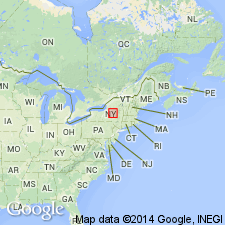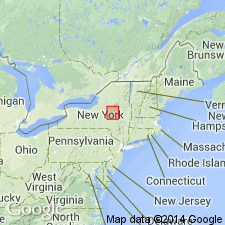
- Usage in publication:
-
- White Creek till
- Modifications:
-
- First used
- Dominant lithology:
-
- Till
- AAPG geologic province:
-
- Adirondack uplift
Summary:
The oldest stratigraphic unit recognized in the western Mohawk Valley is here identified as the White Creek till. Also occurs in lower West Canada Valley. Described as medium to dark blue-gray, calcareous clast-rich diamicton. Type area is along White Creek from confluence of White Creek and Factory Brook, south to West Canada Creek. Dominant clasts are limestone, shale, and dolostone, but also contains many metamorphic clasts. Underlies lower Newport beds and West Canada till. Deposited during Nissouri stade.
Source: GNU records (USGS DDS-6; Reston GNULEX).

- Usage in publication:
-
- White Creek Diamicton
- Modifications:
-
- Named
- Dominant lithology:
-
- Diamict
- Diamicton
- AAPG geologic province:
-
- Adirondack uplift
Summary:
Middleville Formation here newly defined to include all of the pre-Valley Heads deposits currently identified in the West Canada Valley, east-central NY. These include the basal White Creek Diamicton (new name), the lower Newport Beds (new name), the West Canada Diamicton (new name) and the upper Newport Beds. Term diamicton used rather than till because it refers to a nonlithified, poorly sorted mixture of clay to boulders and best describes the deposits in the West Canada Valley. The White Creek unconformably overlies bedrock and is oldest Pleistocene stratigraphic unit identified in the West Canada Creek Valley. Divided into two facies, the valley facies and the Adirondack facies. Boundary between the two is recognized by an abrupt change in texture and metamorphic rock clasts. Valley facies covers the lower West Canada Valley and its Adirondack provenance has been "diluted" by local carbonate rock. The Adirondack facies occurs northeast of Dairy Hill and is composed almost entirely of Adirondack-derived metamorphic rocks and minor sandstone clasts from the north. Middleville is at least as old as the Nissouri stadial (>15.5 ka). Lower age of White Creek is uncertain.
Source: GNU records (USGS DDS-6; Reston GNULEX).
For more information, please contact Nancy Stamm, Geologic Names Committee Secretary.
Asterisk (*) indicates published by U.S. Geological Survey authors.
"No current usage" (†) implies that a name has been abandoned or has fallen into disuse. Former usage and, if known, replacement name given in parentheses ( ).
Slash (/) indicates name conflicts with nomenclatural guidelines (CSN, 1933; ACSN, 1961, 1970; NACSN, 1983, 2005, 2021). May be explained within brackets ([ ]).

